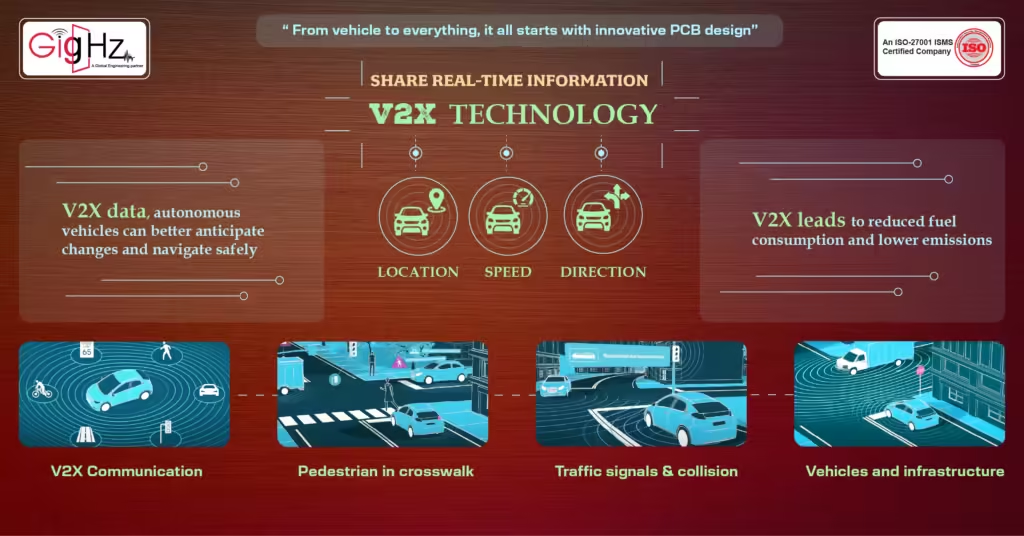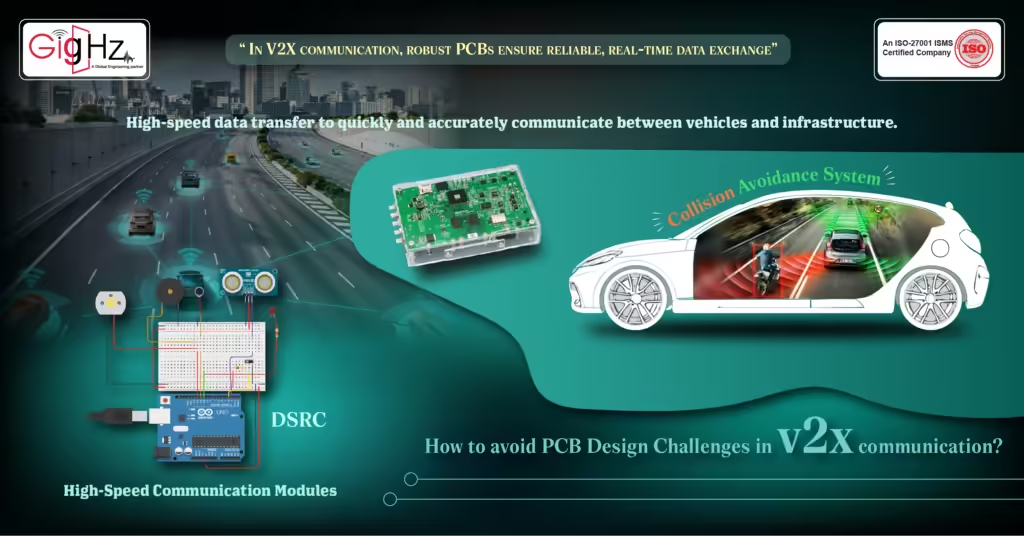
Automotive PCB Design Challenges
Vehicle-to-Everything (V2X) communication is like giving cars a superpower to connect with everything around them.
Here’s how it helps in everyday driving,
Imagine your car can “talk” to other cars and traffic lights.
If another car suddenly brakes or there’s a red light ahead, your car gets a warning and can react in time.
This means fewer accidents because your car can see and respond to things happening around it even before they’re visible.
Your car can get updates from traffic lights and road signs.
If there’s heavy traffic ahead, your car knows in advance and can adjust speed or take a different route.
This helps you avoid traffic jams and get to your destination faster.
For autonomous vehicles, V2X is crucial. It gives these cars detailed information about their surroundings, helping them make smart decisions.
For instance, if the system detects a pedestrian crossing the road, the car can slow down or stop, ensuring safety.
By improving traffic flow and reducing idling, V2X helps cars use less fuel.
For example, if your car knows the traffic lights will soon turn green, it can keep a steady speed and avoid stopping and starting, which saves fuel and reduces emissions.
V2X turns roads into smart networks.
Cars and road infrastructure work together to manage traffic better, making roads safer and more efficient.
For example, it can help adjust traffic light timings based on real-time traffic conditions.
In essence, V2X communication makes driving safer, smoother, and more efficient by helping cars stay connected and informed about their environment.
Why V2X Communication in Vehicle Matters?

V2X technology allows vehicles to share real-time information about their location, speed, and direction with other vehicles and infrastructure. This capability supports collision warnings, lane-change alerts, and emergency braking assistance. For example, if two cars approach an intersection, V2X communication can alert them to each other’s presence, reducing the risk of collision and enhancing overall safety.
By receiving timely updates from traffic signals, road signs, and infrastructure, vehicles can optimize their routes, reduce congestion, and minimize travel time. This integration helps synchronize traffic lights for smoother traffic flow and reduces stop-and-go driving, which connects directly to the improved efficiency of the traffic system.
V2X communication is crucial for autonomous driving, as it provides the data needed for these vehicles to make informed decisions in complex environments. By integrating V2X data, autonomous vehicles can better anticipate changes and navigate safely, which contributes to smoother traffic flow and enhanced safety.
Efficient traffic management facilitated by V2X leads to reduced fuel consumption and lower emissions. By minimizing idling time and optimizing driving patterns, V2X helps vehicles operate more efficiently, promoting a cleaner and greener environment.
V2X technology fosters seamless integration between vehicles and infrastructure, creating a smarter transportation network. This improved coordination enhances overall road safety and traffic management, reinforcing the environmental and efficiency benefits.
How to avoid PCB Design Challenges in v2x communication?

Designing a PCB for an Intersection Collision Avoidance System involves addressing several technical challenges due to the complexity and performance demands of V2X communication. Here’s how these challenges apply to this specific scenario.
- Integrating various communication modules and sensors onto a single PCB for an intersection collision avoidance system is complex. This system must combine high-speed communication modules (like DSRC or C-V2X), GPS receivers, radar sensors, and microcontrollers.
Component Placement: Ensure optimal placement of components to minimize interference. Position high-speed communication modules close to their corresponding connectors to reduce trace lengths and avoid crosstalk.
Routing Complexity: Design PCB routing to manage numerous high-speed signals and power lines. Implement impedance-controlled traces and proper shielding to maintain signal integrity and avoid interference.
Impact: Poor integration can lead to electromagnetic interference (EMI), degraded signal quality, and decreased system reliability, potentially affecting the system’s ability to accurately prevent collisions at intersections.
- The intersection collision avoidance system relies on high-speed data transfer to quickly and accurately communicate between vehicles and infrastructure.
Trace Design: Implement controlled impedance for high-speed signal traces to prevent signal reflections and loss. Use differential pairs for data lines to minimize noise and ensure reliable communication.
Decoupling and Bypass Capacitors: Place capacitors near sensitive components to filter noise and provide stable power, ensuring consistent signal integrity.
Impact: Signal integrity issues can cause data loss or corruption, impacting the system’s ability to provide timely collision warnings and potentially leading to unsafe driving conditions.
- PCB will have multiple communication modules and processing units that generate significant heat. Effective thermal management is essential to prevent overheating.
Heat Dissipation: Incorporate heat sinks, thermal vias, and copper planes to efficiently spread and dissipate heat away from critical components.
Thermal Analysis: Perform thermal simulations to identify heat distribution patterns and address hotspots with additional cooling solutions.
Impact: Inadequate thermal management can lead to overheating, causing performance issues or premature failure of the PCB, which could compromise the collision avoidance system’s effectiveness.
- V2X communication systems in vehicles are exposed to high levels of EMI from other electronic devices and communication systems.
Shielding: Implement shielding techniques such as ground planes and metal enclosures to protect sensitive circuits from external EMI.
Trace Layout: Position high-speed signal traces away from high-current or noisy areas. Use differential signaling and proper grounding to reduce interference.
Impact: Excessive EMI can disrupt communication signals, leading to errors in data transmission and impacting the reliability of the collision avoidance system.
- PCB must endure harsh automotive environments, including extreme temperatures, vibrations, moisture, and dust.
Material Selection: Choose materials with high thermal and mechanical properties, such as laminates with high glass transition temperatures (Tg), to handle temperature variations and mechanical stresses.
Conformal Coating: Apply conformal coating to protect the PCB from moisture, dust, and other contaminants, ensuring long-term durability and functionality.
Impact: Failure to ensure environmental durability can result in PCB degradation and operational failures, compromising the system’s ability to effectively prevent collisions at intersections.
By addressing these challenges, designers can create a robust PCB for an Intersection Collision Avoidance System that enhances vehicle safety and improves traffic management at critical intersections.
Final Thoughts
To avoid PCB design challenges in V2X communication systems, focus on precise component placement, controlled signal routing, and robust thermal management.
Implement effective shielding to mitigate EMI and use durable materials to withstand harsh conditions.
These steps will enhance signal integrity and reliability, ensuring efficient and safe V2X communication.
To know more insights, follow our founder through LinkedIn https://www.linkedin.com/in/chandra-thimma/recent-activity/all/
Latest Post
Get Customized Engineering CAD Design Service

Book a Free Consultation Call
Partner with Gighz and bring your most innovative design concepts to life. Our engineering cad services accelerate development so you can focus on your big vision.
